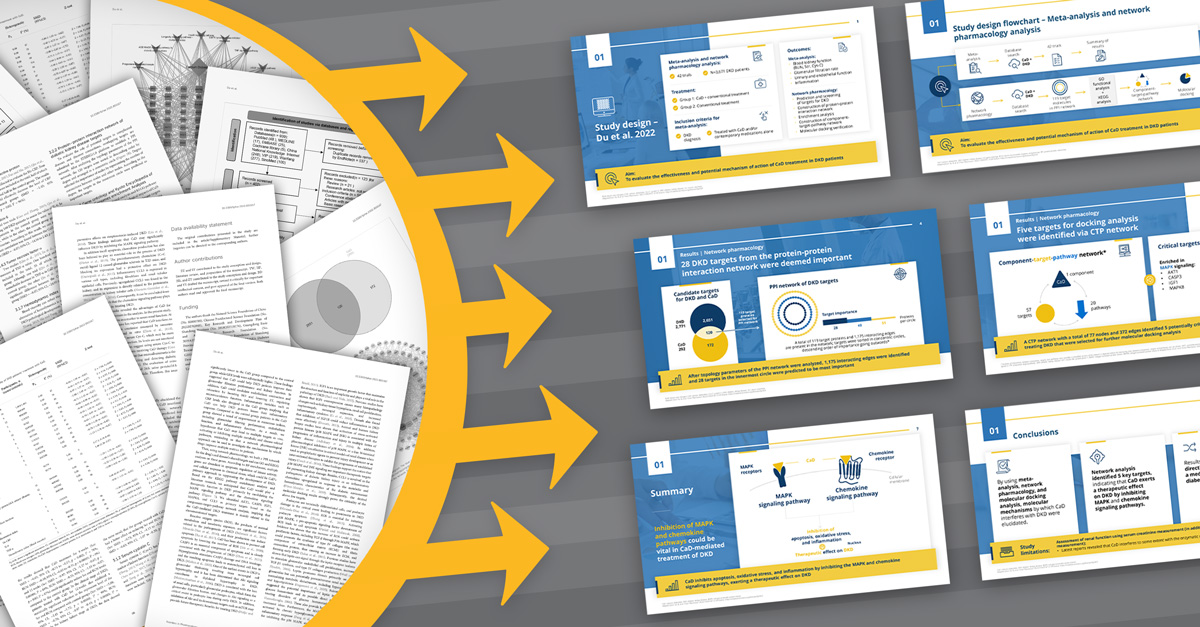Pub-explainer slide decks: Transform a scientific publication into an engaging slide deck
Scientific publications are valuable sources of the latest research findings and study data. Working in pharma, your team relies on this information to keep up to date with the latest developments in their field. Slide decks are often used to disseminate the newest information to internal and external audiences. But it can be challenging to create slides that are both easy to understand and engaging. In this newsletter, we offer some tips to bring publication explainer decks to life.
Identify the most important information
The first step in creating an effective slide deck is to identify the most important information from the scientific publication. This will help you focus on the key takeaways and avoid overwhelming your audience with unnecessary details. If you are working with an agency to create the slide deck, make sure to highlight the most relevant information, as this will save you time and money in the long run.

Take, for example, a clinical study. The key information would include design, inclusion/exclusion criteria, methods, and results. But the “so what” for the therapeutic landscape and your company also need to be considered. How does the study qualify, expand, or reshape our understanding of the therapeutic area? What are the limitations of the study?
Use a slide master template

Using a slide master can save you time and help establish a consistent and recognizable structure for your slides. If your company already has suitable master templates, it’s worth finding them and using them as a starting point. Your template should include design elements and recurring icons, such as study design, inclusion/exclusion criteria, and results. Ensure that abbreviations, footnotes, and references are listed in the footer of your slide. This keeps them easily accessible on the slide without sacrificing information or dedicating too much space to them.
This approach will make it easier for your audience to navigate your slides and quickly find the information they need. If you plan to create multiple slide decks, it’s worth investing in a custom slide master template. It will help ensure a consistent look and feel across your presentations and will save you time and effort in the long run.
Use color, shapes, and icons effectively
![]()
Using colors, shapes, and icons effectively is essential to help readers find the right starting point in a slide. At the same time, it also directs the eye towards the most important information. Make sure to use these elements in a structured and meaningful way.
For example, use colors consistently for specific products and placebo across study design and data visualizations. This ensures that the viewer can quickly distinguish the data points throughout the deck.
Colors, shapes, and icons should establish order and clarity throughout your deck. Think of icons as recurring visual anchors. They make the content rapidly accessible and memorable thanks to the picture superiority effect—the demonstrated phenomenon of images being easier to recall than words.
Avoid overloading slides

When creating a slide deck, it’s important to avoid overloading slides with too much information. It’s tempting to include as much information as possible in the form of text, data, and diagrams, but this can make your slides difficult to read and understand. Always ask yourself whether the information is necessary. It’s also important to keep font sizes consistent throughout your slide deck. Avoid using too many different font sizes, as this can create a disjointed and cluttered look.
Keep in mind that it isn’t the aim of a publication explainer deck to replicate all information from a paper to save the audience from having to read it. The goal is rather to summarize key information to keep them up to date and prime them to then go and read the publication for the details.
Recreate tables, graphs, and illustrations

When including tables, graphs, and illustrations in your slide deck, avoid using screenshots from the original publication. Instead, recreate the figures to fit your design and color scheme. This approach gives you greater flexibility in adjusting the size and placement of the figures and allows you to exclude less relevant information. And that makes it much easier to maintain color consistency (as mentioned above) across charts, diagrams, and tables.
Make the original publication accessible from within the deck

One easy way to boost the benefit for the audience: include a way to quickly access the publication. This can be done by directly embedding a .pdf of the article. Just make sure you have copyright clearance to distribute it! One alternative: if the publication is open access, you can include a QR code linking to it.
Highlight key takeaways

One of the most critical elements of a scientific slide deck is the key takeaways. These are the points that you want your audience to remember and retain from your presentation. To ensure that your audience does not miss these important takeaways, it is crucial to highlight them clearly on every slide. This can be done by positioning the key takeaways consistently across slides (e.g., as a banner across the bottom of the slide), visually delineating them with strong colors and boxes from the remaining slide content, or visually anchoring them with a recurrent icon (e.g., a light bulb, check mark, megaphone, etc.).
Conclusion
Creating an engaging slide deck based on a scientific publication requires a combination of scientific knowledge, design skills, and strategic thinking. Remember to focus on the most critical information and to use visuals, colors, and icons to enhance the presentation’s impact. Pay close attention to the slide’s structure and design to make sure that your audience can easily follow the information presented.
Overall, the goal of a scientific slide deck is to communicate information effectively to your audience. When done correctly, a publication explainer deck can be an incredibly powerful tool to help you share important scientific insights and findings with others.

